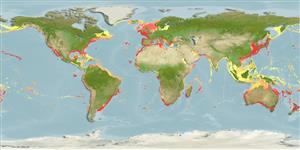>
Syngnathiformes (Pipefishes and seahorses) >
Centriscidae (Snipefishes and shrimpfishes) > Macroramphosinae
Etymology: Macroramphosus: Greek, makros = great + Greek, rhamphos = beak, bill (Ref. 45335).
More on author: Linnaeus.
Environment: milieu / climate zone / depth range / distribution range
Écologie
marin démersal; profondeur 25 - 600 m (Ref. 9563), usually 50 - 350 m (Ref. 47377). Subtropical; 66°N - 43°S, 180°W - 180°E
Western Atlantic: Gulf of Maine to Argentina (Ref. 37039). Eastern Atlantic and Mediterranean. Indo-West Pacific. Mainly in temperate latitudes between 20° and 40°N. Presence in Somalia to be confirmed (Ref. 30573).
Taille / Poids / Âge
Maturity: Lm ? range ? - ? cm
Max length : 20.0 cm TL mâle / non sexé; (Ref. 4508); common length : 12.0 cm TL mâle / non sexé; (Ref. 4508)
Description synthétique
Clés d'identification | Morphologie | Morphométrie
Épines dorsales (Total) : 6 - 8; Rayons mous dorsaux (Total) : 11 - 13; Épines anales: 0; Rayons mous anaux: 18 - 20; Vertèbres: 24. Reddish pink in color, silvery below (Ref. 5382). Body compressed, without scales. Mouth is placed at the end of the long tubular snout (Ref. 35388). Snout length (6.1cm), length of second dorsal spine (LDS 3.9 cm) (Ref. 39875).
Found between the seabed and midwater on the lower continental shelf, over sand. Juveniles found in oceanic surface waters (Ref. 2683); adults normally live close to the bottom (normally in 50-350 m depth (Ref. 47377)). Gregarious. Juveniles feed mainly on pelagic invertebrates, mainly copepods, while adults feed on bottom invertebrates (Ref. 6732). Seems to be sympatric with Macroramphosus gracilis (Lowe, 1839) all around the world (Ref. 89357).
Life cycle and mating behavior
Maturité | Reproduction | Frai | Œufs | Fécondité | Larves
Ehrich, S., 1990. Macroramphosidae. p. 656-657. In J.C. Quero, J.C. Hureau, C. Karrer, A. Post and L. Saldanha (eds.) Check-list of the fishes of the eastern tropical Atlantic (CLOFETA). JNICT, Lisbon; SEI, Paris; and UNESCO, Paris. Vol. 2. (Ref. 4508)
Statut dans la liste rouge de l'IUCN (Ref. 130435: Version 2024-2)
Menace pour l'homme
Harmless
Utilisations par l'homme
Pêcheries: commercial; Aquarium: Aquariums publics
Outils
Articles particuliers
Télécharger en XML
Sources Internet
Estimates based on models
Preferred temperature (Ref.
123201): 6.5 - 22.7, mean 13.6 °C (based on 2092 cells).
Phylogenetic diversity index (Ref.
82804): PD
50 = 0.7502 [Uniqueness, from 0.5 = low to 2.0 = high].
Bayesian length-weight: a=0.00891 (0.00676 - 0.01176), b=2.83 (2.75 - 2.91), in cm total length, based on LWR estimates for this species (Ref.
93245).
Niveau trophique (Ref.
69278): 3.5 ±0.40 se; based on food items.
Résilience (Ref.
120179): Milieu, temps minimum de doublement de population : 1,4 à 4,4 années (K=0.36-0.46; tmax=6).
Fishing Vulnerability (Ref.
59153): Low to moderate vulnerability (27 of 100).
Nutrients (Ref.
124155): Calcium = 110 [58, 243] mg/100g; Iron = 1.23 [0.67, 2.37] mg/100g; Protein = 17.8 [16.5, 19.1] %; Omega3 = 0.456 [0.247, 0.880] g/100g; Selenium = 36.1 [17.7, 78.4] μg/100g; VitaminA = 11.3 [3.0, 42.8] μg/100g; Zinc = 0.741 [0.499, 1.099] mg/100g (wet weight);
